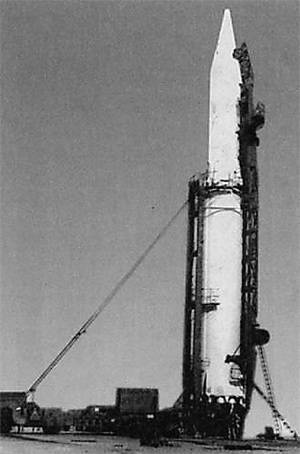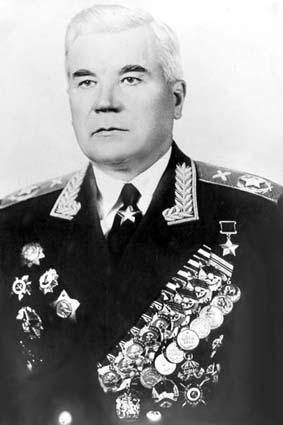Gagarin could fly into space back in December 1960.
 October 26, 1960 in the central newspapers of the USSR there was a message about the death in aviation disaster of the Commander-in-Chief of the Missile Forces of the Chief Marshal of Artillery Mitrofan Ivanovich Nedelin. Everything in it was true, except for one thing: the disaster was a missile.
October 26, 1960 in the central newspapers of the USSR there was a message about the death in aviation disaster of the Commander-in-Chief of the Missile Forces of the Chief Marshal of Artillery Mitrofan Ivanovich Nedelin. Everything in it was true, except for one thing: the disaster was a missile. At the end of the 1950-ies, the United States put on the alert a few dozen intercontinental ballistic missiles. Soviet missiles of the United States could not reach. Developed rocket P-16 was to solve this problem. The Central Committee urged rocket engineers in every possible way: they wanted to launch the successful launch on the anniversary of the revolution - 7 in November 1960. To a large extent, because of this “speeding up” the missile was sent from the factory with unfinished work. October 21 began its prelaunch tests. After 2 of the day, the rocket was refueled and they began to prepare for launch, but they discovered fuel leaks. In the filled state, the P-16 could stand no more than 24 hours - rubber sealing systems could not withstand anymore. Start appointed on October 24 ...
October 24 at 18 hours 45 minutes local time, when the thirty-minute readiness was already announced, at the start was still checking. In addition to the personnel performing the necessary work, there were quite a few other people on the site - members of the state commission, military and civilian specialists. Chairman of the State Commission, Marshal Nedelin, was sitting on a chair next to the rocket.
 Verification tests continued, when suddenly in the depths of the rocket shocks rang out. Following this, a fiery torch burst from the second-stage nozzle. In a matter of seconds, the rocket and launch facilities were consumed by flames Multimeter colossus broke in half and fell on the launch pad. People were in flames, writhing in pain and dying in agony under the lenses of automatic cameras. Those were supposed to capture the successful launch of the P-16. From the memoirs of the commander of the platoon of communications, Senior Lieutenant A. Maslov: “The flames flying through the concrete, licked me all over. I was burning, I thought: it's over. But something prompted, as I was in memory, - run! I ran, but was all engulfed in flames, began to roll in the sand ... I woke up in the hospital on the second day. ”
Verification tests continued, when suddenly in the depths of the rocket shocks rang out. Following this, a fiery torch burst from the second-stage nozzle. In a matter of seconds, the rocket and launch facilities were consumed by flames Multimeter colossus broke in half and fell on the launch pad. People were in flames, writhing in pain and dying in agony under the lenses of automatic cameras. Those were supposed to capture the successful launch of the P-16. From the memoirs of the commander of the platoon of communications, Senior Lieutenant A. Maslov: “The flames flying through the concrete, licked me all over. I was burning, I thought: it's over. But something prompted, as I was in memory, - run! I ran, but was all engulfed in flames, began to roll in the sand ... I woke up in the hospital on the second day. ”Fire hell
As soon as the fire subsided a bit, the rescue services began to work. The picture was terrible. Everywhere
charred corpses that cannot be identified. Among the rescuers, he ran some rank from a special unit and, threatening the officer on duty with a pistol, demanded an answer from him, where Marshal Nedelin did.
In the evening, a telegram left for Moscow: “There are victims up to 100 or more people. The main marshal was on the test site. Now they are looking for him. ” The telegram was signed by the technical test manager and chief designer Mikhail Yangel. He himself was not injured - just a few minutes before the incident went to the smoking room. At least, that’s how Yangel answered Khrushchev’s question: “Why did you stay alive?”
Later, a piece of cloth of a marshal's uniform and deputy badge were found on the ashes. In addition to Nedelin, 57 soldiers and 17 representatives of the defense industry were killed in a fire. In November and December, 11 people also died from burns and poisoning.
The commission of inquiry was headed by Leonid Brezhnev, who immediately told the experts: "We will not punish anyone, all the guilty have already been punished." The report of the commission said that the preparation of the rocket for launch was carried out with the engine starting system filled with fuel and the onboard power supply turned on, which was absolutely impossible to do, it is safer to smoke on the barrel with gunpowder. As a result, there was a premature start of the second stage engine, which burned the bottom of the first stage oxidizer tank with its torch, and then the second stage fuel tank collapsed ...
The successful launch of the P-16 rocket took place only on 2 in February of 1961. Besides human tragedies, this is the largest in stories Soviet cosmonaut catastrophe entailed an important consequence. The launch of the rocket with the first man on board was postponed. Previously, he was scheduled for December 1960.
Information